By Judith Lavoie, The Narwhal. Originally posted on The Narwhal.
The U.S. State Department is not going to intervene in a dispute that has split the International Joint Commission (IJC), despite a letter from U.S. commissioners charging that their Canadian counterparts are refusing to publish data showing the full effects of selenium pollution flowing from B.C. coal mines into Montana.
A State Department official told The Narwhal that there are “no plans to weigh in at this time,” and, instead, both the U.S and Canadian federal governments are urging IJC representatives to work out their differences.
The International Joint Commission, which operates at arm’s length from government, has a mandate to prevent disputes over water quality in transboundary waters and is made up of three representatives from the U.S. and three from Canada.
It is hoped commissioners will reflect on more than a century of collaborative history, said the State Department official.
“The U.S Department of State and Global Affairs Canada hold bilateral meetings every six months to discuss a full range of transboundary water issues. Together we have discussed the issue of mining and potential transboundary impacts at every meeting for the past several years and the two governments continue to seek opportunities for collaboration,” he said.
John Babcock, a spokesperson for Global Affairs Canada, did not directly address the letter from the U.S. commissioners, but said addressing selenium pollution from Teck Resources’ five open pit coal mines in the Elk Valley is a priority.
“Reducing the release of harmful substances found in coal mining effluent discharged into the Elk River and the transboundary Kootenay River basin remains a matter of key importance for Canada,” he said in an emailed response to questions from The Narwhal.
Which throws the federal ball to Environment and Climate Change Canada.
Spokesperson Mark Johnson said the federal government is developing Coal Mining Effluent Regulations under the Fisheries Act, “which would include effluent quality standards for selenium and other harmful substances found in coal mining effluent.”
Environment Canada previously charged Teck Resources under the Fisheries Act after a $600-million treatment plant, that was supposed to address selenium pollution, released selenite, a more bioavailable form of selenium, causing a substantial fish kill.
Last year, the company pleaded guilty and was fined $1,425,000 and the ministry’s enforcement branch is now conducting another investigation into selenium discharges from multiple Teck Coal operations.
Teck, which is investing between $850 million and $900 million to construct water treatment facilities, has also been fined several times for violating provincial environmental rules.
Teck was the single largest donor to the BC Liberal party, which governed B.C. for 16 years until last year. Between 2008 and 2017, the company gave $1.5 million to the BC Liberals. The company also donated $60,000 to the B.C. NDP in that same period.
Canada Advertising for New Commissioners
The solution to the impasse over the Canadian IJC members refusing to endorse a report written by the commission’s health professional advisory board titled “A Review of Human Health Impacts of Selenium in Aquatic Systems” may come in a change of faces around the table.
There are two empty chairs on the commission — one Canadian and one U.S. — but the Canadian government is asking for applications for commissioners including the possibility of the full time chair position.
Canada’s current commissioners are Gordon Walker, a non-practicing Toronto lawyer and Richard Morgan, a Montreal consultant.
Dave Hadden, director of Headwaters Montana, said the split at the IJC shows the commission not functioning in a healthy manner and change would be welcome.
“Back in the 1970s and the 1980s it functioned as an independent body. It looked at facts and data and made fair, impartial decisions, but, during the Harper era, it was politicized with the IJC representatives for Canada strategically placed to represent the government position rather than looking at the science,” said Hadden, who has been involved in transboundary water issues for almost four decades.
The letter from the U.S. commissioners appears to be an attempt to improve the commission’s objectivity — something increasingly important in the current U.S climate where denial of facts and science is becoming commonplace, Hadden said.
“I would hope the IJC commissioners would have a heart-to-heart and say they are going to work more objectively and not be so political,” he said.
No Long-term Studies of Selenium Levels in People Downstream of Coal Mines
Hadden believes that much of the agenda is being controlled by Teck and that is one of the elements that sparked the letter complaining that the Canadians wanted to omit recent data showing increasing amounts of selenium pollution flowing into the transboundary Koocanusa reservoir.
“Teck is not innocent in how that U.S. section letter came about. It reflected a process of being manipulated by industry,” Hadden said.
The report has not been officially submitted to either federal government, but a copy obtained by The Narwhal shows it includes a case study of selenium pollution flowing from B.C.’s mountaintop removal coal mines into U.S. waterways and points out that there have been no long-term studies of selenium levels in people living downstream from the Elk Valley coal mines.
Much of the report relies on existing studies of the effects of elevated selenium levels in humans and fish, leading some to question why the Canadians would object to scrutiny of health risks, especially as one of three municipal water supply wells in Sparwood was recently shut down because of selenium contamination and data shows selenium concentrations are four times higher than B.C.’s own drinking water guidelines in Fording River and Line Creek.
Most of the issues voiced by the U.S. commissioners have already been raised with the State Department, Environmental Protection Agency and the IJC, by the Confederated Salish and Kootenai Tribes (CSKT), said Rich Janssen, the natural resources department head for the tribes.
In an emailed response to questions Janssen said there is not enough data to understand the impacts of mining and there is concern about lack of access to Teck Coal’s data “and the obvious issue of the industry proponent collecting the data.”
“Confederated Salish and Kootenai Tribes have asked the IJC and Department of State for an objective scientific process and this letter from the commissioners raises the same concern,” Janssen said.
“The report flags the human health impacts of selenium, which is poorly understood in the Elk/Kootenai watershed and has been raised by CSKT as a key concern for protecting traditional cultural uses,” he said.
The Health Impacts of Selenium
Small amounts of selenium are needed by humans, but large doses can cause problems such as gastrointestinal disorders, nerve damage and cirrhosis of the liver. In fish, selenium can cause defects such as missing gill plates, curvature of the spine and reproduction problems.
Selenium, leaching from waste rock at the Elk Valley coal mines, seeps into the Elk and Fording Rivers in B.C. Those rivers flow into the Koocanusa Reservoir on the border, then into the Kootenai River in Montana before curling back into Canada at Creston and on to the Columbia River.
“Environmental impacts from mining can be devastating and long-lasting, even after rehabilitation and reclamation. Recognition that poor mining practices and lack of government regulation has provided conditions favorable for selenium bioaccumulations in the environment is increasing,” says the IJC report, referring to a highly critical 2016 review by B.C. Auditor General Carol Bellringer, who said the province has been monitoring dramatic increases in selenium levels in the Elk Valley for 20 years, but has taken no substantive action to solve the problem.
The report says that, although a 2007 assessment, funded by Elk Valley Coal Corp., concluded that adverse health effects from moderate consumption of fish with elevated selenium levels were negligible, a 2017 study warns of the dangers for subsistence fishers, including First Nations.
The problem should be addressed by both countries working together and sharing data the report recommends.
Fishing Guides Worried About Selenium Pollution
Meanwhile, fishing guides in the area are wondering whether species such as bull trout will survive the growing selenium pollution.
John Avery, a semi-retired fishing guide from Fernie, said there is no baseline data because the problem was ignored for years by industry and governments.
“The company knew about this in the 1980s and maybe the 1970s and nothing was done,” said Avery, who added that he gave up going to information meetings organized by Teck after he was told the selenium “is not killing fish, it is just killing bugs in the river.”
“If the bugs disappear, the fish disappear. They can’t go to McDonald’s,” he said.
Teck spokesman Chris Stannell said research and monitoring indicates that concentrations of selenium and other substances are not affecting fish populations, but certain types of mayflies may be affected.
“Further study work is being undertaken to determine the cause. Factors may include both mining-related and natural factors, such as nitrate concentrations, temperature trends and annual variation in river flow,” he said.
Fishing guide and fly shop owner Paul Samycia said he sees many facial and cranial deformities in fish, although fish numbers are not dropping in areas where the trout are able to reach clean water for spawning.
“But I do worry that this might not be a career that will last a lifetime,” he said.
And no one seems to know how to fix the problem, Samycia said.
“I think the coal mining companies waited too long and tried to hide it and now it’s exploded in their face,” he said.
“It’s a catastrophic problem that the mining companies are up against. It’s not as if you can plug the hole. You can’t shut the mines down because then who is going to pay for the cleanup?”
Main image: Teck’s Greenhills mountaintop removal coal mine, in B.C.’s Elk Valley. Credit: Garth Lenz
Subscribe to our newsletter
Stay up to date with DeSmog news and alerts







